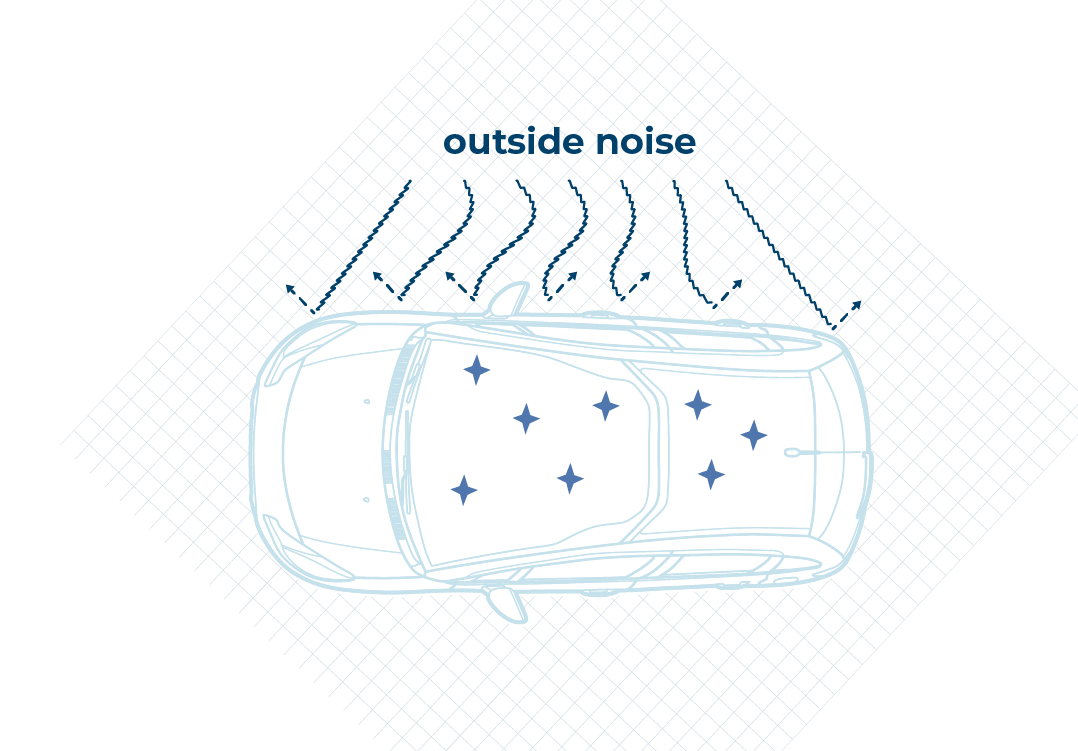Dampening sound
Sound abatement is the reduction of noise or the management of sound in a space. Dampening wind and other road noise is a primary focus of automotive OEMs, suppliers and other industrial manufacturers. Modern consumers also demand a comfortable vehicle interior, which includes a low-noise environment. Quiet signifies quality and workmanship. To meet that demand, Argent has developed a variety of solutions and unique composites that can be custom converted for sound-dampening applications.


Noise and sound basics
Sound is simply energy emitted when objects vibrate; for example, when vehicle components shake back and forth. Sound waves travel from their source through air, water and other objects as vibrations. When those vibrations reach our eardrums, our brain interprets them as sound (or noise).
Noise Types
There are two different types of noise, air-borne and structure-borne. Airborne sound is transmitted through the air. Structure-borne noise happens when an object hits a surface.
Methods to mitigate or reduce noise
There are many techniques and technologies used to manage sound in vehicle interiors. Two of the most common are noise dampening and noise absorption.
Materials and applications for sound abatement
Foam composite
Foam composite is best for noise abatement jobs that need a strong and rigid solution. Our foam composites can be designed with custom combinations of films and other laminates to create fully tailored solutions for your industry specifications. Another benefit of foam composites is that they are easier to handle in certain manufacturing scenarios, especially when gloves are required.
Foam tape
Foam tape provides moderate sound dampening and is highly versatile. Foam tape is available in several thicknesses, densities and adhesive systems. Argent designs foam tapes made from PVC, rubber, polyester, polyethylene and urethane constructions.
Noise dampening reduces vibration in physical structures.
Noise absorption dissipates airborne sound waves through absorption.
LDPE
Low-density polyethylene film is excellent as a solution for low-cost wind noise applications. LDPE provides minimal sound dampening but is flexible and conformable, which is important when surfaces are complex. LDPE has an aggressive acrylic adhesive system, which means it will adhere to most clean, dry surfaces.
Acoustic absorbers
3M Thinsulate™ and polyester/non-woven pads can block very loud noises and meet the needs of extreme noise dampening in automotive interiors. 3M Thinsulate™ is often chosen as an alternative to bulky, heavy pads and can be die cut to custom shapes for improved sound absorption and noise-dampening performance.
Foil tape
When the primary noise issue is from metal, foil tape is often the best choice. Argent can work with foil tape, mating aluminum foil with acrylic transfer adhesives or foam tape for an effective attachment solution that will also dampen metallic noise.
Solutions for wind noise issues
Argent’s Design Team solved a challenging wind noise issue on a popular SUV using specialty die-cut foam tape. Our design features a high-performance acrylic adhesive system and economical PVC foam. The highly conformable foam effectively blocks the troublesome wind noise channeled through the irregular surfaces between the door and A-pillar.
Noise abatement solutions
As a tier 1 automotive OEM provider, die cutter and converter, Argent International is a recognized leader in the automotive industry.
Let’s discuss your next project today.
Contact Us
